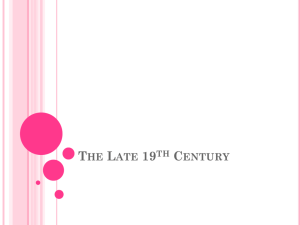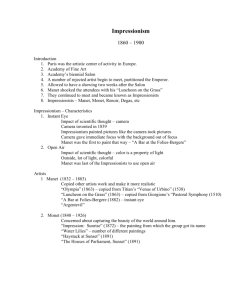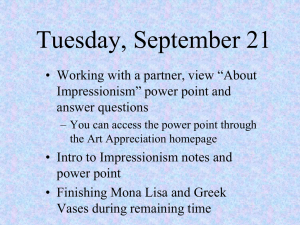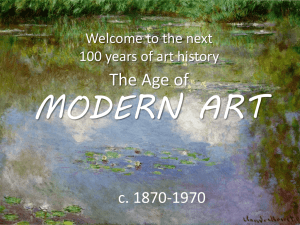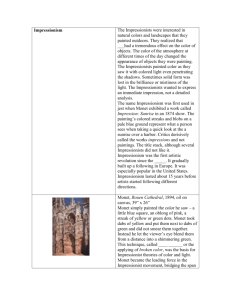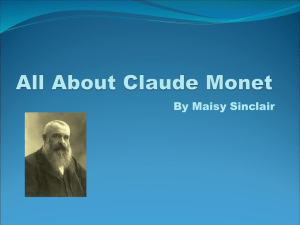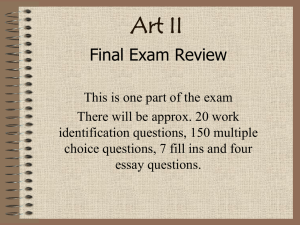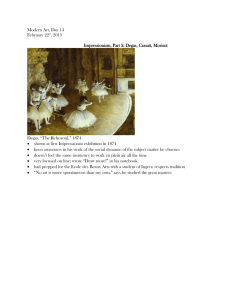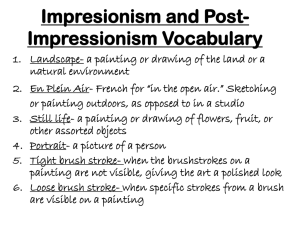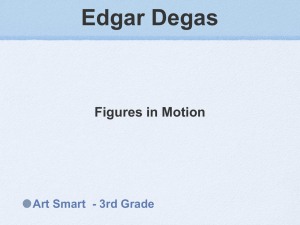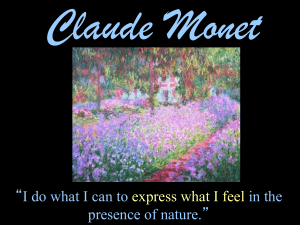Impressionism
advertisement
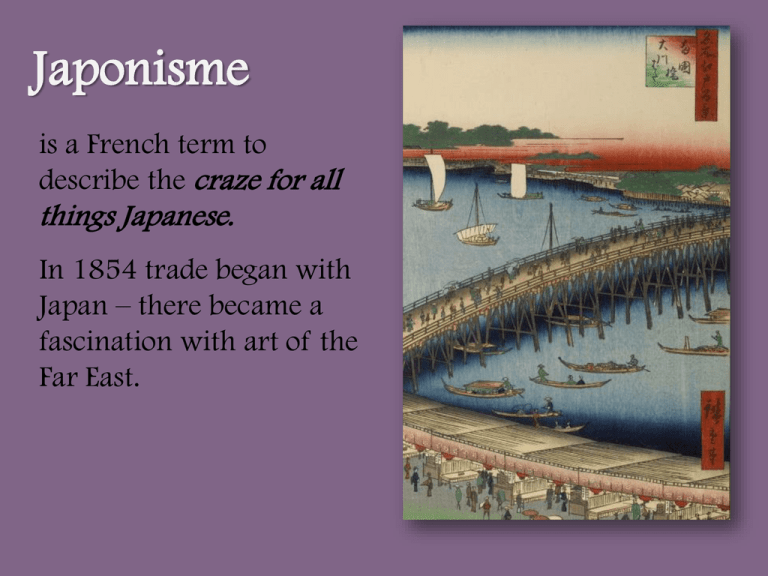
Japonisme is a French term to describe the craze for all things Japanese. In 1854 trade began with Japan – there became a fascination with art of the Far East. Ukiyo-E (meaning floating world) was the golden age of woodblock prints. Big influence on Impressionists. Similar subject matter. An ART Movement is when a group of artist, who are familiar with each other, work in a similar style during the same period of time. Impressionism The impressionist style is characterized capturing the general impression produced by a scene or object and the use of unmixed primary colors and small strokes to simulate actual reflected light. Impressionism Evolved in France between 1860s-1890s Impressionism The Impressionists’ works rarely respond to political events Its content is very different from the Realists’ focus on social commentary Impressionism •Scenes of daily leisurely activities •Loose brushstrokes •Pastel colors (with blues and violets replacing blacks and browns) •Lack of a structured composition •Natural lighting The Impressionists were REBELS They painted “PLEIN AIR” meaning outside and not in a studio. Edouard Manet, Luncheon on the Grass, 1863. Titan, Pastoral Concert, 1510 Manet exhibited it at the Salon des Refusés (Salon of the rejected). He was admired by Monet and his friends, and he became the leader of the Impressionist movement 1510 HIGH ITALIAN RENAISSANCE Edouard Manet, Olympia, 1863. Edouard Manet, Olympia, 1863. Titian Venus of Urbino, 1510 Manet Zola , 1868 A writer who wrote about artists being free to purse their own aesthetic inclinations. Manet, A Bar at the Folies-Bergère” 1882. More impressionistic. A slice of life. Claude Monet Impressionist paintings incorporated the sketchesabbreviations, speed, and spontaneity- qualities of What critics might call shortcuts Claude Monet He exhibited this work in the 1st Impressionist show in 1874. The work was “finished in the sense of a complete thoughtthe capture of a specific moment in time” Impression Sunrise” 1872. Claude Monet No attempt to smooth the brushstrokes or blend the pigmentsto create the smooth meticulously detailed image that the Academy liked Impression Sunrise” 1872. Claude Monet Because of the title, the very unimpressed critics called the work Impressionismunfinished sketches, not real art. Impression Sunrise” 1872. Impressionism started as a derogatory term, but as the work found fans, the name stuck in a positive way Monet lived in extreme poverty until the 1880s when Impressionism started to catch on Claude Monet, Hay stacks . 1890 Claude Monet, Rouen Cathedral, 1894. Claude Monet, The Magpie, 1890. Claude Monet, Rocks At Belle-Ile, Port-Dormois, 1886. Claude Monet, Waterlillies, 1920 Claude Monet The Japanese Bridge 1899. Pierre-Auguste Renoir Painted “happy pictures” He avoided black paint. He sought to paint a “slice of life” Renoir Luncheon of the Boating Party, 1881. Renoir La Moulin de la Galette, 1876. Renoir, Oarsmen at Chatou, 1879. Renoir On The Terrace, 1881. Edgar Degas ”Ballet Figures tend to run-off sides diagonal compositions Rehearsal”, 1876. Edgar Degas, The Dance Class, 1874. Edgar Degas The Dancing Class 1875. Edgar Degas, Horses Before the Stands, 1866. Edgar Degas Jockeys Before The Race 1870. Degas, Racehorses at Longchamp, 1875. Edgar Degas L’Absinthe 1876. Degas, Four Dancers, 1899. Chalk Pastel. Degas He was never interested in creating public monuments, Rarely displayed his sculpture publicly. The Little 14-Year-Old Dancer. It was Modeled in wax and wearing a real bodice, stockings, shoes, tulle skirt, and horsehair wig with a satin ribbon. Mary Cassatt •American Daughter of a Philadelphia banker •Befriended by Degas •Primary subject mother and child The Bath, 1892. Degas Cassatt Renoir Cassatt Mary Cassatt Mother and Child, c1889. Mary Cassatt Mother and Child, 1889. Mary Cassatt Summertime, 1894. Kitagawa Utamaro Woman with Baby 1860s Mary Cassatt Maternal Caress, 1891. Mary Cassatt, The Boating Party, 1894. Berthe Morisot •exhibited with the Impressionists •Manet was her brotherin-law, grandfather was Fragonard •Mostly domestic scenes Loose brush strokes, pleinair lighting effect Berthe Morisot The Cradle, 1872. John Singer Sargent 1856-1925 Most successful portrait painter of his time Painted almost 900 oil paintings and 2000 watercolors in the bulk of his career Born to American parents in Florence, Italy; Studied at the Salon in France; eventually moved to London Self-Portrait, 1907. Sargent, Madame X, 1884. Madame X was a socialite and wife of wealthy Pierre Gautreau. Viewers were shocked at the first exhibition of this piece as Sargent painted her right strap falling off the shoulder, considered to be very suggestive at the time. Portrait of Sargent in Studio, 1884. Sargent Daughters of Edward D. Boit, 1882. John Singer Sargent, Lady Agnew of Lochnaw 1892-93. Winslow Homer, 1836-1910 American Landscape / Seascape Painter illustrator for Harper’s Weekly Magazine- sent to the Civil War to frontlines to sketch and paint scenes Eventually switched to watercolor Best known for his seascapes while living in Prout’s Neck, Maine Winslow Homer, Home Sweet Home 1863. Oil on Canvas. Winslow Homer, Snap The Whip, 1872. Oil on Canvas. Winslow Homer, Northeaster, 1895. Oil on Canvas. Winslow Homer, The Gulf Stream 1899 John Singleton Copley, Watson and the Shark, 1778. Reoccurring theme, Life and death and the forces of nature. He was never swayed by critics James Abbott McNeill Whistler He had a unique personality Whistler Arrangement in Gray and Black (Whistler’s Mother), 1871. Whistler Nocturne in Blue and Gold (the Falling Rocket), 1875 This became the center piece where ART was on trial. Whistler Libel Trial: Whistler vs Ruskin ( an art critic) Ruskin accused him of being an impostor and of “fling a pot of paint in the public’s face”. …charging exorbitant pricesWhistler said that he may have only spent a day and a half on the painting, but he was charging for a lifetime of experience! Whistler He won the suit, but was given what amounted to about $1 for his troubles. “Art for Arts sake”you can’t legislate taste.
